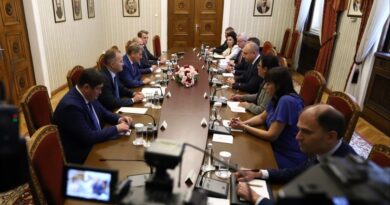Azeri gas: is Europe serious?
Everybody loves Azeri gas. And yet, Central, East, and Southeast European markets are flooded with Russian gas. Why? Because the authorities of the European Union (EU) are lacking in vision and leadership on the question of how to achieve their declared aim of diversifying away from energy dependence on Russia. Instead, Brussels contents itself with occasionally issuing frankly silly proposals that are guaranteed not to work. As the end of Russian gas transit through Ukraine looms, the issue is becoming urgent. The European Commission (EC) needs to use its executive and regulatory power to correct an anomalous situation. And soon!
Everyone, but everyone, seems to want gas from Azerbaijan! The fan club includes Slovakia, Croatia, Serbia, the Czech Republic, Ukraine, Moldova, Italy, Albania, Greece, Bulgaria, Romania, and various other countries. They are proclaiming, loud and often. that they aspire to import Azeri gas as a viable alternative to the Russian variety.
Brussels: leading the way to energy independence?
Well. fine. But the European Commission (EC) – feeling compelled to propose interim solutions to help those cute European Munchkins along the Yellow Brick Road to a glorious zero-emission future – is consistently failing to guarantee either the long-term demand or the investments needed to secure production and transmission capacities.
Now, this is a short-term as well as a long-term problem. The end of this year will see the expiry of the contract between Russia and Ukraine for westward transit of Russian gas to European (mainly EU) states. And, for reasons that we will discuss below, that contract is extremely unlikely to be renewed. What with the war and everything, the volumes involved in such transit are, understandably, not what they used to be. About 15 billion cubic metres (bcm) per year is being carried by a set of pipelines with a design capacity of 120+ bcm. But that’s still a lot of gas and it will need to be replaced somehow. Since the EC is a founder member of the Azeri Gas Fan Club, it would obviously love the replacement gas to be, as far as possible, from Azerbaijan. But the Commission is, to put it politely, not being very effective about it.
Instead, Brussels, in its collective wisdom, periodically comes up with inept ideas. One, mooted in June this year, involved routing the replacement Azeri gas – the gas that is to supplant Russian gas – via Russia!?
Now, while these ideas are always short-lived, they are swiftly succeeded by equally impractical ones the latest is to divert all the Azeri gas that currently enters Turkey for local consumption – around 10 bcm – to the EU, while compensating Ankara by ‘allowing’ to utilise as much Russian gas as it wishes. That one was reported by Bloomberg earlier this month and to this day the suggestion hasn’t been dropped. Nor, however, has it been accepted by Ankara or Baku (or in transit countries other than Turkey and Azerbaijan: for it has raised considerable and valid concerns. Their response has, quite logically, emphasised the need for binding long-term contracts to justify the infrastructure investments, both inside Turkey and after the Bulgarian-Turkish border, that would be required.
This dynamic is fueled by the EC’s assertion of a pan-European foreign and climate policy which incorporates (and, in truth, is rather dominated by) the Green Deal – and seems to affect the energy security of individual nation-states. Specifically, during the European Council meeting of May 2022, EU leaders emphasised the need to accelerate efforts to reduce dependence on Russian energy sources. One of the key documents outlining this intention is the EC’s “REPowerEU” plan, which was presented in March 2022. This plan includes strategies to phase out Russian gas and diversify energy sources.
There is, indeed, a goal of ending Russian gas imports by 2027. Well, sort of.. This specific commitment was not formalised as a binding legal decision. But key EU figures – including EC President Ursula von der Leyen – stated that the EU would aim to end its reliance on Russian fossil fuels by 2027 or as soon as possible, with a significant caveat: that this would depend on member states’ ability to adapt. The timeline reflects the urgency to find alternative energy sources and increase energy independence across the EU.
However, the Commission has yet to provide either clear and coherent leadership in this matter or a clear long-term route-map. Which leaves individual member states to look for individual ways out. And that often means that they are competing for scarce non-Russian gas alternatives in a ‘sauve-qui peut’ endgame.
If you like this article, please support us with a donation to PayPal and to the direct account of the association Alternatives and Analyses IBAN BG58UBBS80021090022940. This will ensure that there will be further analyses
Kyiv’s war agenda
Meanwhile, it is fast becoming more and more likely that Russian gas transit through Ukraine will cease by end-2024. Not least because the situation is being exacerbated by Russian strikes that target Ukraine’s gas infrastructure. Those align with the Kremlin’s broader strategy of exploiting the energy sector as part of a geopolitical manoeuvre that might be called an “Energomor” – an artificial energy famine analogous the grain-based “Holodomor” with which Soviet despot Joseph Stalin starved Ukraine’s peasantry into submission in the 1930s, leaving millions dead.
Kyiv’s recent decision to sanction Lukoil’s crude oil transit to Slovakia and Hungary signals a proactive response to Moscow’s aggression, compelled by the need to protect its energy systems. But it is a sign of despair rather than a well-thought-out move, as Slovakia is essential to Ukraine’s military and energy imports.
As Ukrainians endure the current heatwave, responding with restricted consumption and energy conservation measures, they can look forward to murderous cold before too long, as Russian president Vladimir Putin’s ominous designs for next winter threaten to deprive them of adequate heating and energy, promising physical harm and devastation within their homes.
Against this background, the need to diversify gas supplies – in particular replacing the 15 bcm of Russian gas currently being transited through Ukraine – seems vital for Central Europe (which includes the Czech Republic, Slovakia, Hungary, Austria, Slovenia and Croatia.
However, things aren’t so simple.
The efforts of Austria and the Czech Republic to secure additional volumes of gas through Germany face challenges to do with supply, capacity and price.
As to the potential for Azeri gas supplies via Turkey, that hinges on Azerbaijan’s production capacities. And these, while expanding, are far from sufficient to bridge that 15 bcm Ukrainian transit gap. Azeri gas supplies to the EU are projected to increase by just 1.8 bcm this year to 13 bcm – for which destinations ranging from Italy to various Eastern European countries will be vying.
Meanwhile on the Gazprom front – les grandes idées
But, meanwhile, Russia’s Gazprom has a plan!
Slightly before Mr Putin’s trip to Beijing in May this year, a somewhat less exalted being – Gazprom CEO Alexei Miller was hastily dispatched to the Iranian capital Tehran. There he proceeded to offer some really bombastic gas deals.
This trip and its timing were perhaps entirely or mostly a matter of negotiating tactics. One aim of Mr Putin’s coming journey was to overcome the reluctance of Chinese president Xi Jinping to import more Russian piped gas and sign a long-term supply contract, so it made bargaining sense to emphasis the fact (or the pretence) that Russia had alternatives. This said, however, Gazprom appears to have put some thought into Mr Miller’s bombast. And it’s just possible that Mr Miller actually believed what he was saying.
One of Russia’s most influential energy experts, Mikhail Krutikhin, disclosed, in an interview for the independently-minded YouTube channel Feigin Live, that Gazprom intended to redirect the surplus of Russian gas rejected by Europe – all 109.5 bcm of it! — through the Caspian Sea to Iran. The scheme is, apparently, making progress (at least on the media front), with Tehran taking the lead in PR terms. This initiative, says the Kremlin, would position Iran as the predominant gas hub in a region spanning North Africa, the Middle East, and Europe.
Now, it’s unclear what genre of entertainment we’re dealing with here – low comedy, high drama, or surrealist farce. But what is clear is that the idea is ludicrous and half-baked.
Iran and Qatar share ownership of the South Pars/North Dome gas field. That’s not only the world’s largest gas field, but it’s also eminently viable in economic terms. Its estimated gas and gas condensate reserves, totaling over 51 trillion cubic metres (tcm), are equal to the identified reserves of most of the world’s gas fields put together. So why would Iran want to base its strategy and positioning on the international gas market on disposing of Russian gas that Europe doesn’t want?
Look at the paradox. Iran imports and consumes natural gas from Russia at a reported price of $100 per 1,000 cubic metres (m3)– which is rock-bottom in terms of international markets, but way more than the price at which Iran could produce indigenous gas. And yet Iran is neglecting the development of its abundant domestic resources. A modest net exporter of natural gas, Iran primarily trades with Turkey, Iraq, Armenia, Azerbaijan, and Pakistan—exporting about 18 bcm per year while boasting production of 270 bcm and domestic consumption in the range of 220-230 bcm. It does not have the import, transmission, or export infrastructure to become more of a player on the international market. There has been much talk of construction of a robust new underwater pipeline to Iran beneath the Caspian Sea by the Russian authorities and Gazprom. However, it is no less imperative to prioritise the enhancement of Iran’s domestic gas transmission system and its export capacity. After all the country’s gas consumption is forecast to double by 2033.

As to export, there are grandes idées of joint endeavours between Russia and Iran to construct pipelines to Pakistan and India and LNG terminals which will rival Qatar and flood the Asian market. But these seem to be more political wishful thinking than practical and well thought-out market ideas.
Above all, the scheme would require the investment of hundreds of billions of dollars in new infrastructure to deliver gas for which there is no assured market. Even if Russia and Iran had normal access to international capital markets – which of course they don’t – those would not finance such a project. And neither state has piles of cash ready to self-finance it. So sustaining the investments needed is out of the question.
There’s also the little oddity that Russia is thinking to construct its own its own Caspian-seabed pipelines while simultaneously threatening gunboat diplomacy to block trans-Caspian gas supplies from Turkmenistan to Azerbaijan!
Furthermore, the notion of selling Russian gas at a premium through Iran to Turkey and Europe appears far-fetched when Turkey is still hesitant to commit whole-heartedly to direct Russian gas imports and the Turkish Gas Hub project. And the pursuit of diversification in Central, East and Southeast Europe is gaining momentum as it becomes more and more urgent to secure alternatives to Russian gas via Turkish gas pipelines or LNG terminals.
Where all ends meet – the Bulgarian-Turkish border
As the dynamics of the situation unfold, Ankara’s reluctance to accept the EU’s offer of a swap deal in which the EU would take over the entirety of Turkey’s imports of Azeri gas—roughly 10 bcm—reflects valid concerns. Acceptance would tether Turkey heavily to Russian gas, jeopardising the country’s diversification efforts and diminishing the substantial brokerage (or “laundering”) revenues to be derived from blending Russian with non-Russian gas into the Turkish Gas Hub mix (TGM): after all, the less non-Russian (e.g. Azeri) gas there is in that mix, the less convincing the TGM is and the less Turkey is contributing to the exercise. The delicate balance between cooperation and rivalry in the dealings of Turkish president Recep Tayyip Erdogan and Mr Putin underscores the complexities at play.
Despite reports of fresh gas discoveries in Turkey, more is needed to alter that nation’s status as a substantial net importer of natural gas in the foreseeable future.
And, no matter what measures are adopted by the EC to secure alternative non-Russian gas imports in response to the coming disruption of Ukrainian transit, there’s one place where the reverberations will be felt most keenly: the Bulgarian-Turkish border! Deservedly or not, Bulgaria again finds itself bearing some of the burden of geopolitics.
The EC holds the keys – anti-trust moves and additional tax
Meanwhile, there are compelling reasons to scrutinise Gazprom’s pricing strategies, do so urgently, and do something about them.
After all, how is it that gas be priced at $360 per 1,000 m3 in the Netherlands, $280 in Turkey, and only $100 in Iran? This disparity challenges market dynamics and suggests that something underhand is happening.
What to do? Well, an anti-dumping inquiry would no doubt produce interesting (though perhaps not very surprising) results. But it would do so with much delay; and delay is something we can’t afford.
No, the way to go in the short term is to impose an additional tax on Russian piped gas imports at the EU border.
That would “level the playing field” for Gazprom’s rivals, ensuring they were competing with Gazprom on equal terms. It would harmonise prices across various segments of the ostensibly integrated European gas market. And it would enhance the feasibility of numerous LNG terminal projects and the transmission infrastructure connecting them with gas networks and consumers, thus augmenting LNG supply and an improving diversification prospects.
Ultimately, a combination of both anti-trust measures and a border tax might offer the most robust approach to counteract Russian pipeline gas dumping. Implementing anti-trust measures could pave the way for healthier market competition in the long term, while a border tax could provide immediate relief and incentives to shift towards alternative energy sources. In determining the most appropriate course of action, the European Commission would need to consider its strategic goals and the potential for geopolitical ramifications, but it would also need to bear in mind the urgency of the situation.
Which, gentle reader, is where we came in….
Ilian Vassilev




